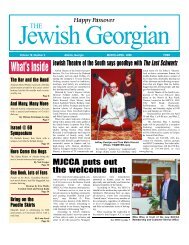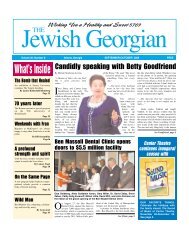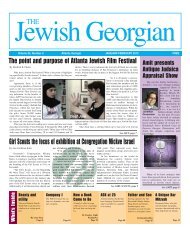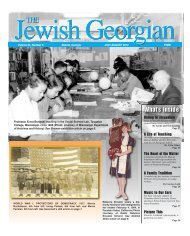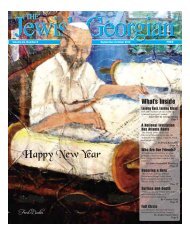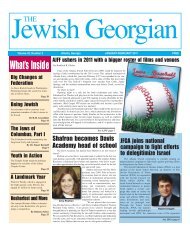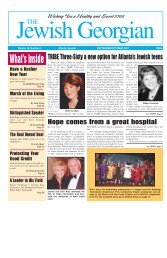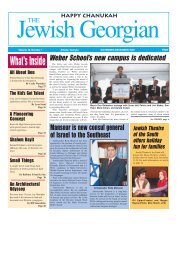JGA Mar-Apr 10 - The Jewish Georgian
JGA Mar-Apr 10 - The Jewish Georgian
JGA Mar-Apr 10 - The Jewish Georgian
You also want an ePaper? Increase the reach of your titles
YUMPU automatically turns print PDFs into web optimized ePapers that Google loves.
<strong>Mar</strong>ch-<strong>Apr</strong>il 20<strong>10</strong> THE JEWISH GEORGIAN Page 23<br />
Albany<br />
From page 21<br />
Wessolowsky was a very gregarious and<br />
popular fellow and won election to the<br />
town’s Board of Alderman in 1870. In<br />
1875, he was elected to the first of three<br />
terms in the state legislature.<br />
Wessolowsky also became a leader of<br />
the local <strong>Jewish</strong> community. He convinced<br />
other local Jews to form a Hebrew<br />
Benevolent Society to help those in need,<br />
and he founded the congregation’s religious<br />
school with his wife. Wessolowsky was<br />
active in both the Masons and B’nai B’rith,<br />
which had been established in Albany in<br />
1873.<br />
Wessolowsky was more successful in<br />
politics than in business and thus happily<br />
left the retail trade behind when he agreed<br />
to become the associate editor of the <strong>Jewish</strong><br />
South newspaper in 1877. <strong>The</strong> paper had<br />
been founded by Rabbi E.B.M. Browne of<br />
Atlanta. Wessolowsky spent four years with<br />
the newspaper. He often traveled across the<br />
South, selling newspaper subscriptions and<br />
organizing local chapters of B’nai B’rith.<br />
As early as 1871, the editor of Albany’s<br />
local newspaper noted that “no people on<br />
earth are more liberal in benevolent projects<br />
or social enterprises” than Albany Jews.<br />
Two of the most important of these civic<br />
leaders were Samuel B. Brown and Joseph<br />
Ehrlich.<br />
Samuel B. Brown was born in Atlanta<br />
in 1855 to German-<strong>Jewish</strong> parents. His<br />
family moved to Albany in 1869. As a<br />
young man, he worked<br />
as a store clerk before<br />
becoming a partner in<br />
his own firm,<br />
Greenfield and<br />
Brown. He later<br />
owned a high-end<br />
men’s clothing store.<br />
According to a<br />
history of Dougherty<br />
S.B. Brown<br />
County, Brown’s “rise<br />
in the business world<br />
was without interruption,<br />
and he finally<br />
became the leading businessman of<br />
Albany.” Brown was a big local booster,<br />
helping to finance many local enterprises.<br />
He founded several businesses in Albany,<br />
including the Planters Oil Company, the<br />
Flint River Brick Company, the Exchange<br />
Bank, and the Albany National Bank; he<br />
was the longtime president of both banks.<br />
Brown was elected mayor in 1901 and 1902<br />
and also served several terms on the Board<br />
of Aldermen. When he died in 1922, the<br />
local newspaper reported that “a wave of<br />
sorrow swept over the splendid city he had<br />
helped to build.”<br />
Joseph Ehrlich came to the United<br />
States from Prague in 1868. After spending<br />
some years in Connecticut, he moved to<br />
Albany in 1875, where he opened a clothing<br />
store and tailoring business. In 1881,<br />
Ehrlich opened a shoe-and-hat store, which<br />
became a big success. Ehrlich was first<br />
elected to the Albany Board of Aldermen in<br />
1888; he went on to serve as an alderman<br />
Rabbi Edmund Landau (seated) with B’nai Israel’s confirmation class in 1900<br />
for 33 years. He was also a longtime member<br />
of the local board of education and secretary<br />
of the local Masonic Lodge for 21<br />
years.<br />
Ehrlich and Brown were also leaders of<br />
the local <strong>Jewish</strong> community. Brown served<br />
as Beth Israel’s president from 1894 until<br />
his death in 1922; Ehrlich took over the<br />
office for the next sixteen years.<br />
Perhaps because of the prominence of<br />
men like Brown and Ehrlich, Jews enjoyed<br />
tremendous acceptance in Albany. Jews<br />
were welcomed into the local country club;<br />
in fact, Brown served as its longtime president.<br />
Bertha Brown and Lily Hofmayer<br />
both served as president of the Albany<br />
Women’s Club, in which many other <strong>Jewish</strong><br />
women were active. Several other Albany<br />
Jews served on the Board of Aldermen,<br />
including E.H. Kalmon and Morris<br />
Wessolowsky, Charles’son.<br />
Jews were also actively involved in<br />
education in Albany. Henrietta Sterne, the<br />
daughter of <strong>Mar</strong>x and Caroline Smith,<br />
founded a private school in 1877. She ran<br />
the school, known as the A. Sterne Institute,<br />
until she left Albany for Anniston,<br />
Alabama, in 1888. <strong>The</strong> school continued<br />
under the leadership of her sister-in-law<br />
Pauline Sterne until it closed in 1917.<br />
During its early years, B’nai Israel met<br />
in the Mayer Building and later in the<br />
Welch Building in downtown Albany. In<br />
1882, the congregation built a small synagogue<br />
on the corner of Jefferson and Broad<br />
streets. Fourteen years later, members built<br />
a new, larger temple on the corner of<br />
Jefferson and Oglethorpe. Many congregation<br />
members built houses in the area<br />
around the synagogue in the early 20th century.<br />
Despite its small size, the congregation<br />
was first able to hire a rabbi in 1885. While<br />
B’nai Israel’s first three rabbis stayed only<br />
one year each, in 1889, F.W. Jesselson was<br />
brought in to lead the congregation and<br />
ended up staying for nine years. In 1898,<br />
the congregation hired a 22-year-old graduate<br />
of the Hebrew Union College, Edmund<br />
A. Landau, who would spend the next 47<br />
years leading B’nai Israel. He married a<br />
local girl, Rosa Geiger, who had been in his<br />
first confirmation class.<br />
Generally, it was the women who took<br />
the lead in the Albany <strong>Jewish</strong> community’s<br />
charitable efforts. In 1878, a group of thirteen<br />
<strong>Jewish</strong> women founded the Hebrew<br />
Ladies Benevolent Society. Its goal was to<br />
help those in need, regardless of religion.<br />
<strong>The</strong> group furnished rooms at the local hospital<br />
and provided free lunches to poor<br />
schoolchildren. For over a century, the<br />
Hebrew Ladies Benevolent Society was the<br />
charitable arm of the Albany <strong>Jewish</strong> community;<br />
it remains the oldest <strong>Jewish</strong><br />
women’s organization in Georgia. In 1895,<br />
Albany women founded the Ladies’Aid<br />
Society, which later changed its name to the<br />
Temple Sisterhood. <strong>The</strong> two women’s<br />
organizations existed together for over a<br />
century, with the Benevolent Society<br />
focused on helping those outside of the congregation<br />
and the sisterhood supporting the<br />
work of B’nai Israel. In 2006, the two<br />
organizations, which largely had the same<br />
membership, finally merged.<br />
As in other Southern towns, most<br />
Albany Jews were involved in retail trade.<br />
Already by 1871, the city had 22 <strong>Jewish</strong>owned<br />
stores. During the late 19th century,<br />
<strong>Jewish</strong> immigrants continued to settle in<br />
Albany, seeking economic opportunity.<br />
In 1892, Jacob Rosenberg moved to<br />
Troy, Alabama, where he opened a store<br />
with his brothers Abraham and Isaac. After<br />
he met Annie Cohn during a visit to Albany<br />
in 1895, Jacob persuaded his brothers to let<br />
him open a branch store there. After marrying<br />
Annie, Jacob ran the Rosenberg<br />
Brothers store in Albany for the next 42<br />
years, until he died in 1938. In 1925, Jacob<br />
built a new downtown store, which had<br />
three stories and a basement, as well as two<br />
elevators. Rosenberg Brothers became one<br />
of the largest and most successful stores in<br />
Southwest Georgia. When Jacob died,<br />
every store in town closed for his funeral.<br />
<strong>The</strong> business was carried on by Jacob’s son<br />
Joseph and later by grandson Ralph<br />
Rosenberg. In 1991, Rosenberg Brothers<br />
finally closed due to increased competition<br />
from discount chain stores.<br />
Rosenberg Brothers Store, built in<br />
1925<br />
Many of Albany’s <strong>Jewish</strong>-owned businesses<br />
were downtown, centered around<br />
Broad Street. In 1930, Issac Minsk, New<br />
York Bargain House, Rosenberg Brothers<br />
Department Store, Prisant Brothers<br />
Department Store, Louis Prisant Jewelers,<br />
and J. Ehrlich Shoes and Hats were clustered<br />
together on just two blocks of Broad<br />
Street.<br />
<strong>The</strong>se businesses were hard hit by the<br />
tornado that devastated Albany on February<br />
<strong>10</strong>, 1940. Since several business owners<br />
lived close to their stores, many of their<br />
homes were damaged as well. In a letter to<br />
the editor of <strong>The</strong> Southern Israelite, Rabbi<br />
Landau declared, “<strong>The</strong>re is scarcely a member<br />
of the congregation who has not suffered.”<br />
<strong>The</strong> tornado also did serious damage<br />
to B’nai Israel’s synagogue. Part of its north<br />
wall was destroyed, the roof was damaged<br />
beyond repair, and all of the windows were<br />
blown out. According to the local newspaper,<br />
B’nai Israel suffered more damage than<br />
any other house of worship in Albany. After<br />
the congregation was displaced by the tornado,<br />
B’nai Israel ended up meeting regularly<br />
in the local Masonic Temple, while a<br />
new synagogue was built on the same site<br />
as the old one.<br />
B’nai Israel’s synagogue was severely<br />
damaged by the tornado that<br />
struck Albany’s downtown in 1940.<br />
Albany was soon able to rebuild from<br />
the tornado with the help of World War II,<br />
which brought a lot of activity to the military<br />
bases in the area. With this wartime<br />
bustle, Albany’s <strong>Jewish</strong> community continued<br />
to grow. <strong>The</strong> <strong>Jewish</strong> population went<br />
from 290 in 1937 to 475 in 1960, before<br />
peaking at 525 in 1968. B’nai Israel grew as<br />
well, from 70 members in 1940 to 150 in<br />
1962. <strong>The</strong> 1950s and ‘60s were the peak<br />
years for the Albany <strong>Jewish</strong> community,<br />
See ALBANY, page 37



